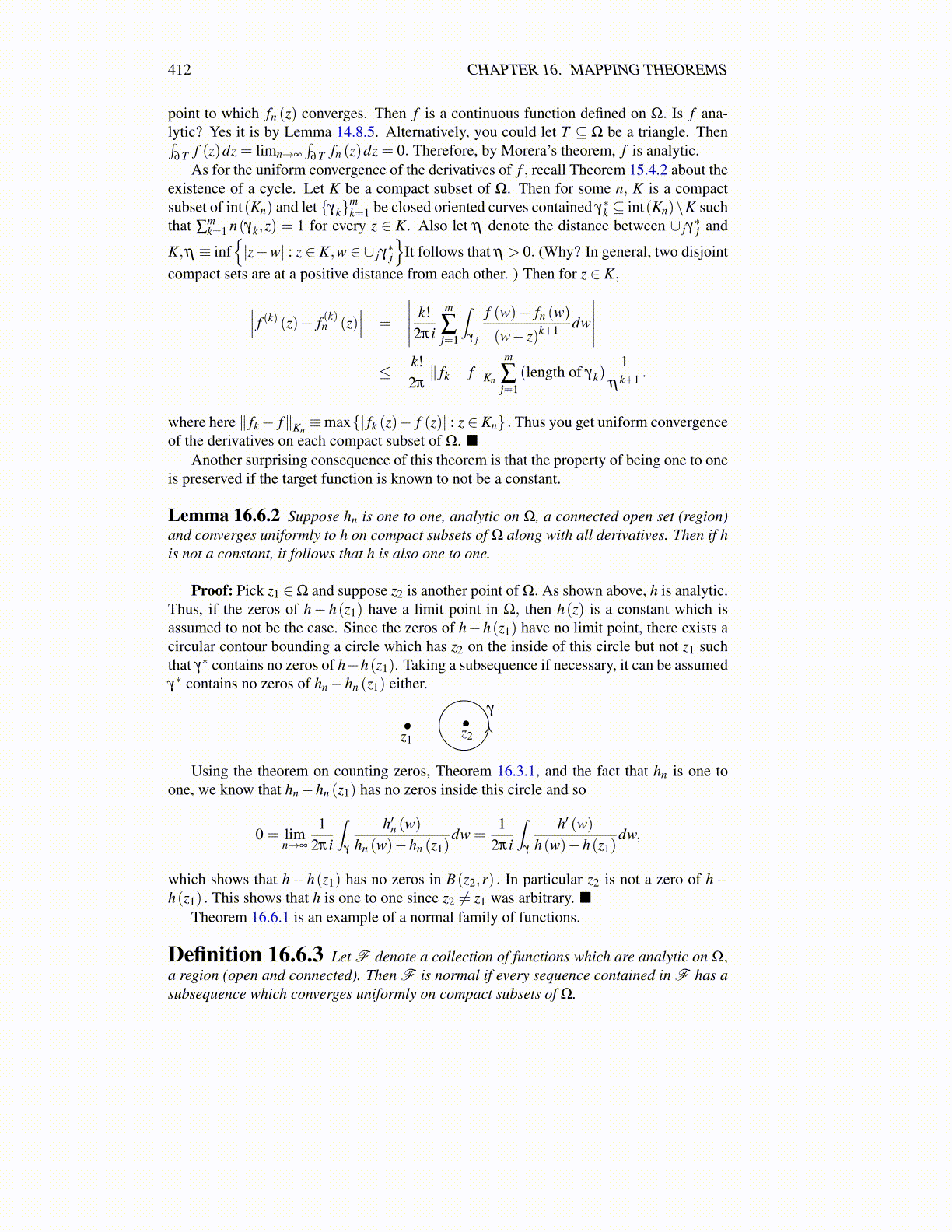
412 CHAPTER 16. MAPPING THEOREMS
point to which fn (z) converges. Then f is a continuous function defined on Ω. Is f ana-lytic? Yes it is by Lemma 14.8.5. Alternatively, you could let T ⊆ Ω be a triangle. Then∫
∂T f (z)dz = limn→∞
∫∂T fn (z)dz = 0. Therefore, by Morera’s theorem, f is analytic.
As for the uniform convergence of the derivatives of f , recall Theorem 15.4.2 about theexistence of a cycle. Let K be a compact subset of Ω. Then for some n, K is a compactsubset of int(Kn) and let {γk}
mk=1 be closed oriented curves contained γ∗k ⊆ int(Kn)\K such
that ∑mk=1 n(γk,z) = 1 for every z ∈ K. Also let η denote the distance between ∪ jγ
∗j and
K,η ≡ inf{|z−w| : z ∈ K,w ∈ ∪ jγ
∗j
}It follows that η > 0. (Why? In general, two disjoint
compact sets are at a positive distance from each other. ) Then for z ∈ K,
∣∣∣ f (k) (z)− f (k)n (z)∣∣∣ =
∣∣∣∣∣ k!2πi
m
∑j=1
∫γ j
f (w)− fn (w)
(w− z)k+1 dw
∣∣∣∣∣≤ k!
2π∥ fk− f∥Kn
m
∑j=1
(length of γk)1
ηk+1 .
where here ∥ fk− f∥Kn≡max{| fk (z)− f (z)| : z ∈ Kn} . Thus you get uniform convergence
of the derivatives on each compact subset of Ω. ■Another surprising consequence of this theorem is that the property of being one to one
is preserved if the target function is known to not be a constant.
Lemma 16.6.2 Suppose hn is one to one, analytic on Ω, a connected open set (region)and converges uniformly to h on compact subsets of Ω along with all derivatives. Then if his not a constant, it follows that h is also one to one.
Proof: Pick z1 ∈Ω and suppose z2 is another point of Ω. As shown above, h is analytic.Thus, if the zeros of h− h(z1) have a limit point in Ω, then h(z) is a constant which isassumed to not be the case. Since the zeros of h−h(z1) have no limit point, there exists acircular contour bounding a circle which has z2 on the inside of this circle but not z1 suchthat γ∗ contains no zeros of h−h(z1). Taking a subsequence if necessary, it can be assumedγ∗ contains no zeros of hn−hn (z1) either.
•z1
γ•z2
Using the theorem on counting zeros, Theorem 16.3.1, and the fact that hn is one toone, we know that hn−hn (z1) has no zeros inside this circle and so
0 = limn→∞
12πi
∫γ
h′n (w)hn (w)−hn (z1)
dw =1
2πi
∫γ
h′ (w)h(w)−h(z1)
dw,
which shows that h− h(z1) has no zeros in B(z2,r) . In particular z2 is not a zero of h−h(z1) . This shows that h is one to one since z2 ̸= z1 was arbitrary. ■
Theorem 16.6.1 is an example of a normal family of functions.
Definition 16.6.3 Let F denote a collection of functions which are analytic on Ω,a region (open and connected). Then F is normal if every sequence contained in F has asubsequence which converges uniformly on compact subsets of Ω.